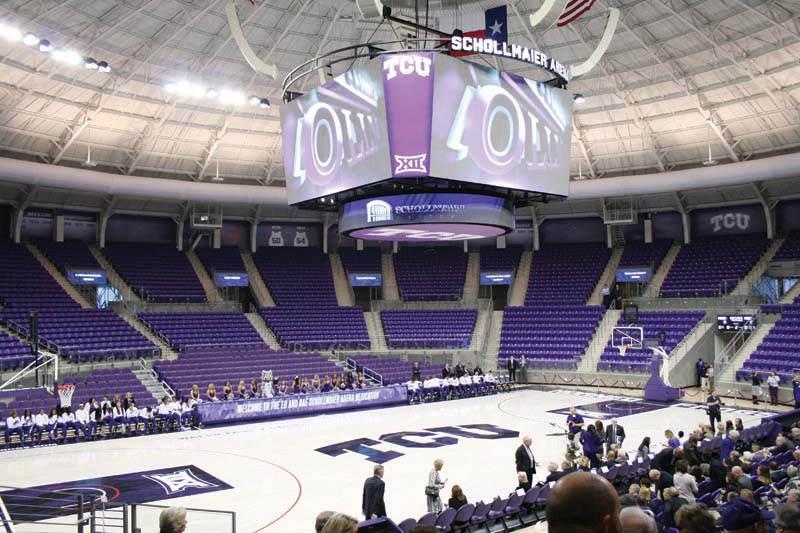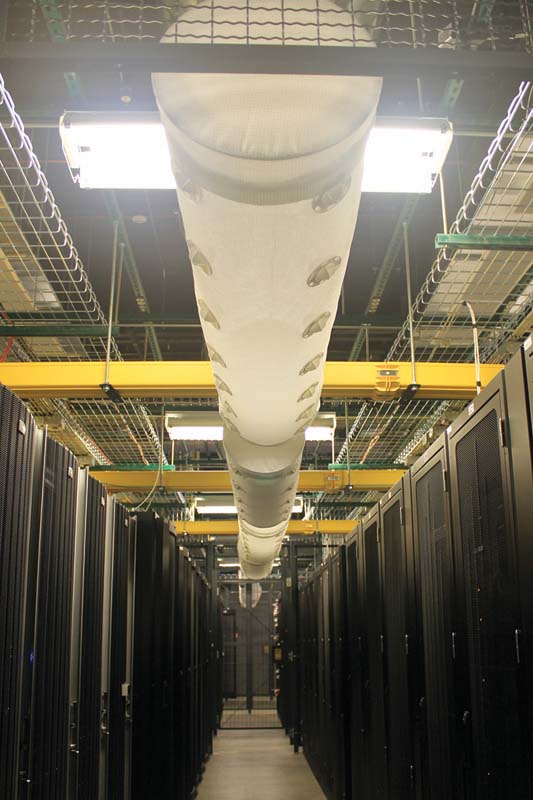
Combination fabric diffuser/spot cooling
The fabric diffuser/spot-cooling hybrid method was recently developed specifically for data centers. The fabric-based diffusers employ porosity combined with field-adjustable nozzles for spot cooling.
While conventional fabric duct porosity is too miniscule to be seen with the naked eye, data center fabric diffuser micro pores are definitively visible. The fabric diffuser porosity slows the potential higher air velocity down to allow a gentle descent toward the equipment rack façades. Air velocities below 1.2 m/minute (400 fpm) allow electronics equipment fans to draw it into the cabinet. These systems are positioned directly above the cold aisle. Cold air not drawn into racks will settle near the floor, pushing (or displacing) warmer air out of the cold aisle and up to the ceiling.
The diffusers also incorporate adjustable nozzles that can direct air toward high-wattage servers and higher-density racks—both growing industry trends. The 360-degree rotatable hemispherical diffusers secured inside 50 or 76-mm (2 or 3-in.) diameter housing (i.e. 15.5-L/s, 124.4-Pa [33-cfm, ½-in. w.g.] or 39-L/s, 124.4-Pa [83-cfm, ½-in. w.g.]) are designed to snap into the factory-cut orifices. The nozzles also have an anti-condensation design to eliminate concerns of moisture formation on the material. In applications where aisles are not full, the nozzles can also be closed off to save energy.
This data center air dispersion is also factory-engineered to offer displacement delivery that does not entrain warm air from the hot aisle, essentially creating a configuration of separate cold/hot aisles without having physical partitions between the two. This results in a 1.6 to 2.8-C (3 to 5-F) colder aisle temperature, but with up to 20 to 40 percent less CRAC flow rates, especially when complemented with variable frequency drive (VFD) equipment. It also helps achieve lower power usage effectiveness (PUE) levels, which is a metric for measuring infrastructure energy efficiency for data centers.
Further, the fabric used in these systems has built-in anti-static qualities from its electrostatic dissipative (ESD) yarn, which is specifically designed for electric-sensitive environments such as data centers. It also disperses a small 12.7 L/s/m2 (2.5-cfm/sf) of airflow through a traditional fabric portion of the product. This accounts for about one percent of its total porosity versus the aforementioned micro-pore strategy.
Thus, the push for better dispersion in the form of slower airflow and better directionality will drive the data center industry toward these more high-tech air distribution solutions in the future. A good example can be found with Involta, a provider of data centers, cloud services, and information technology (IT) outsourcing. The Cedar Rapids, Iowa-based firm has developed more than 23,780 m2 (256,000 sf) of co-location data centers operating in Arizona, Pennsylvania, Ohio, Minnesota, Iowa, and Idaho. The facilities, which have either metal or traditional fabric ductwork not specifically designed for data equipment operations, are amid a roll-out conversion to combination fabric diffuser/spot cooling dispersion, according to the company’s chief security officer, Jeff Thorsteinson. Converted centers have demonstrated reduced air velocities, lower dB sound levels, and better efficiency as measured by PUE.
For example, Involta recently converted its Marion, Iowa, facility that previously used metal duct air distribution. The deployment, which also included mechanical modifications, reduced airflow by 40 percent, but maintained the same cooling temperatures due to better air distribution. Combined with some server and storage device change outs, the Marion facility HVAC retrofit reduced electric utility usage by 80,000-kWh/month, Thorsteinson said.

Reducing UFAD temperature differential
Over the last decade, the trend in office ventilation has been toward UFAD where cabling, piping, utilities, and HVAC ventilation are concealed below raised floors, but also easily accessed through floor panels for reconfiguration, additions, or retrofits. A new fabric duct product developed especially for such assemblies helps improve the air distribution system’s temperature control to result in greater occupant air comfort and fan energy reduction.
The typical 305 to 460-mm (12 to 18-in.) high raised floor creates a convenient plenum to distribute air. Conditioned air typically pressurizes the plenum from building supply trunk line ductwork. The pressurized plenum forces conditioned air up into the occupied space through adjustable floor diffusers that can be incorporated into any 0.6 x 0.6-m (2 x 2-ft) floor panel. Office workers can adjust the floor diffuser closest to their workspace for personal temperature control.
UFAD’s greatest challenge is thermal decay (i.e. heat escape) at the perimeter, especially near solar gain sources, such as windows or exterior walls. Getting air to the perimeter is sometimes a pressurization challenge facility managers try to alleviate by raising the space temperature. This, in turn, makes inner spaces too cold near the building core. Increasing fan speeds on variable speed designs is a very inefficient and sometimes ineffective solution. Temperature differences from the perimeter to the inner areas near the building core can vary as much as 5.5 C (10 F) when UFAD does not operate efficiently.
The fabric duct solution to UFAD air distribution challenges consists of 305 to 460-mm (12 to 18-in.) diameter fabric duct lengths that are factory-modeled for every project. They connect to the plenum’s metal supply ductwork to deliver air where it is most needed. In perimeter thermal decay incidences, for example, air can be dispersed directly near floor diffusers where there are employee air comfort complaints. The duct flexibility easily makes it reconfigurable for routing around the inherent myriad of cabling, piping, vertical floor supports, and other concealed obstacles commonly found in UFAD systems.
A case in point is the new $47-million Mitchell Park Library & Community Center (Palo Alto, California), which recently opened with acclaim for its indoor air quality (IAQ) and controllable air comfort. The 3716-m2 (40,000-sf) library, and its accompanying 1486-m2 (16,000-sf) community center, is one of California’s most sustainable projects, according to Debra Jacobs, PE, PMP, LEED AP, a project engineer with the city’s Public Works Department.
While added ductwork is many times a UFAD retrofit remedy, the LEED Platinum-certified building’s consulting engineer Tunde Munz, PE, LEED AP
(a principal with San Francisco-based firm Guttmann & Blaevoet [G&B]), specified it in the library’s design phase to safeguard against potential temperature differential swings. G&B has designed dozens of buildings using UFAD and often incorporates fabric duct for better efficiency and indoor air comfort.
“As I walk through the building, the temperature is amazingly consistent, even when comparing the west and east portions of the building in the late afternoon’s setting sun,” said Jacobs.




